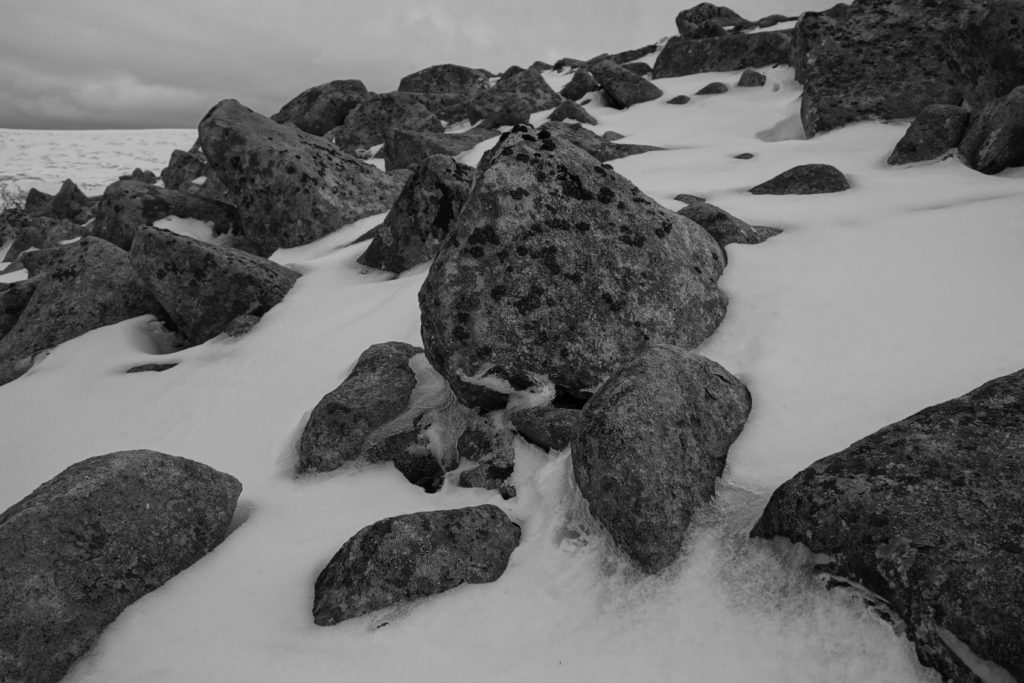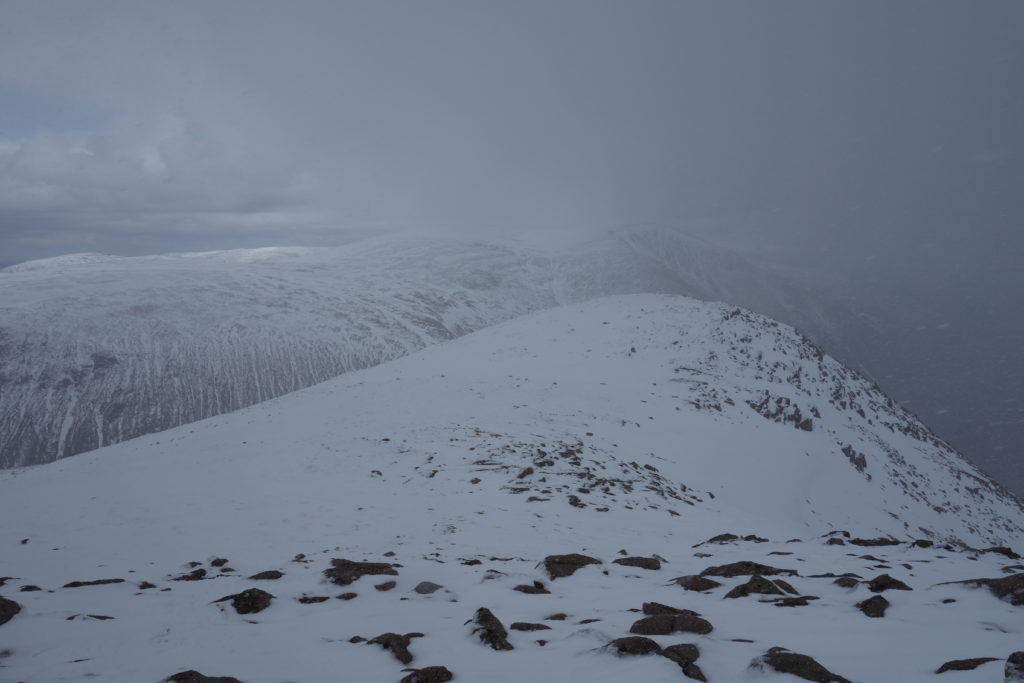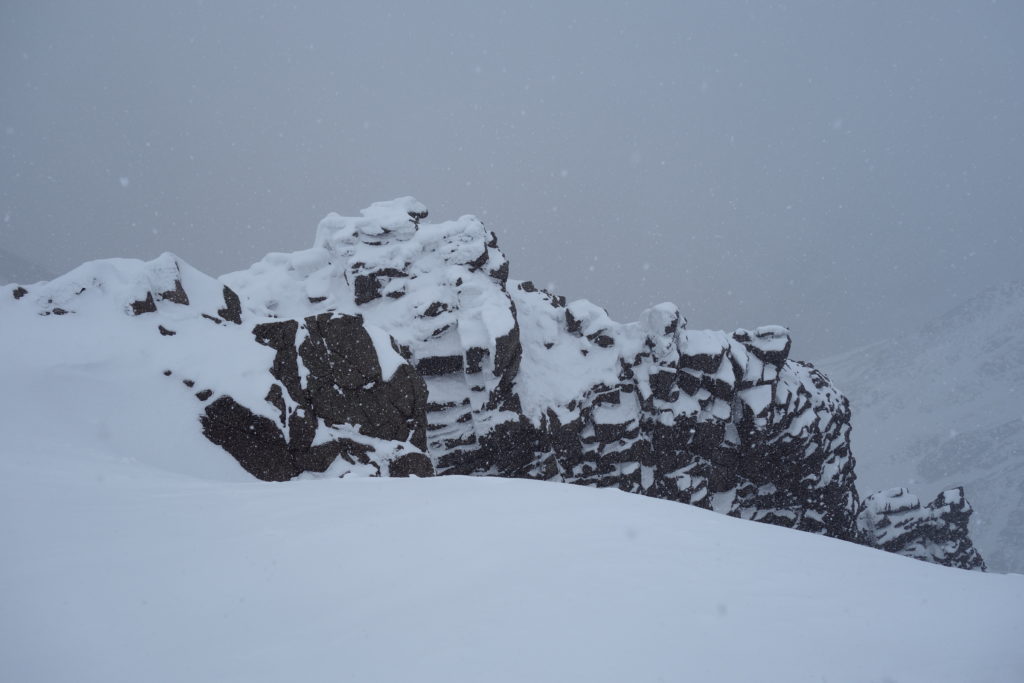In her latest column from the Cairngorms, Anna Fleming gets to know a vast and subtle mountain.

How does one know a mountain?
Of all the mountains in the Cairngorms, there is something about Braeriach. It is not the tallest one here – across the Lairig Ghru, Ben Macdui stands a little higher. Bynack Mor and Ben Mheadhoin have more interesting summits, studded with weathered granite tors that delight hand and eye. Braeriach is vast and subtle. At the top, one does not find a peak, but a widening plateau that rolls out into Am Moine Mhor (the Great Moss) and sharpens at the edges, leading on into the more defined peaks of Sgor an Lochan Uaine and Cairn Toul. Braeriach means ‘brindled upland’ and, perhaps more than any other single mountain here, the hill encapsulates the Cairngorms.
From Strathspey, Braeriach seems accessible. Unlike the peaks hidden within the body of the Cairngorm massif, Braeriach overlooks the wide river valley. A coating of snow brings light and shadow, revealing vivid details in Braeriach’s exposed flanks and corries. The mountain advances. But looks are deceptive. Braeriach is a long way. You must allow for eight hours of steady walking, ascending over one thousand metres. On short winter days, this means starting in the dark.
The first time I walked up Braeriach, the mist was down. We spent hours walking in thick, damp cloud, following a trail of disturbed pink granite through grass, lichen and boulders. I was desperate to know the mountain: I wanted to reach the summit and take in the views – but there were no views. With visibility reduced to a few damp metres, I wondered, what makes this Braeriach and not any other cloud-clad hill? What can my body tell me about this place? I noticed the rise and fall of the ground. The gradient eased and I grew cold. A ptarmigan scuttled away, snarling through the rocks. We passed iron-brown tubes scattered among clean, shining metal plates: the mangled remains of an airplane. Wind blasted up gullies and granite buttresses. We found an edge and called it the top.

Last October, I discovered another aspect of Braeriach. One Sunday a surprise snowfall dusted the autumn leaves. The mountains gleamed white. I headed up Glen Einich to the long, deep glacial loch that nestles within a towering horseshoe of hills. I walked with longing. Overhead, Braeriach shone. Perhaps I should change my plans, make a detour, push up the slopes, and climb the hills. But the snow was fresh and deep. The effort would be immense.
All was not lost. At the loch, I found Braeriach. The mountain was held in the water. The distant skyline landed at my feet in a perfect mirror image. I studied the surface, reading the hollows, pockets, streams and corries; each line sharpened by snow. Then I looked through the mirror. In the crystal water, I saw the rocky surface of a distant planet. Softening my eyes, I allowed the elements to mingle. Water, mountain, snow, stone and sky. Smooth and rough. Dark and light. Reflection and shadow. The mountain was in the loch and the loch was in the mountain.

As I watched, the dark stream-lines began to stretch and bend. The mountain was pulled apart – bars twisted in widening zig-zags before the elastic snapped and the image fragmented. Braeriach retreated. Wind had ruffled the surface.
Recently, I returned for another shot at the problem. This May, surely, I would get the summit views. Surely, this time, I would grasp Braeriach. The forecast seemed fair; the days were long. Down in the strath, green surged across the fields. Gorse burned golden and the hills deepened into indigo. Cuckoos and willow warblers sang from new leafed birch. Yet spring had not reached the mountain. The hillside was still bleached brown and yellow. A caterpillar sat on the corner of a stone, clad in a thick coat.
Higher up, the boulder field was half-submerged in a still white sea. The snow formed frozen crusts and eddies around the stones. Higher still, the sun broke through, igniting the crystals. The moment was Alpine: pause for sun lotion and sunglasses. Higher again: I reached the summit ridge, and snow blew in. Thick feather flakes flew and swirled on a slight breeze, pattering against my hood. The hills disappeared. All turned white and grey. The flakes hardened into polystyrene balls. I had climbed back into winter.
Time stretched as I paced the drifts, hoping for a clearing. Space became surreal. I had walked into the immense and remote Cairngorm plateau – but as the storm moved in, I could see and hear only a few metres. I hunkered down inside my hood, hat and mittens. The quiet was eerie. The air was still, yet full of snow. I had met no one all day, but as I waded back to the summit, suddenly someone was right at my heels, crunching the snow behind me. I spun around – and there was no one there. Unsettled, I continued.

Back at the summit, I got my window. The snow eased and space expanded. Distance returned. I saw thick cornices hanging over the Lairig Ghru and there was Lochan Uaine, a steely grey mirror below Angel Peak. Sun light fell on a southern hill. I turned back, and the elements intensified. Sky met ground in a driving flurry of wet snow. Footprints faded. The white-out was bewildering. Everything looked the same. I could be anywhere. I turned around to check the conditions behind me, and was instantly disorientated. In this skyless, groundless, featureless white, I almost went the wrong way.
And so my journeys into Braeriach reveal and frustrate. The mountain advances – I am drawn in; the mountain retreats – I am pushed back. When the mountain is generous, I land and soar. An eye blinks, and the mountain closes in. Braeriach sharpens its teeth and I become a ptarmigan, scurrying for shelter, snarling through the boulders.